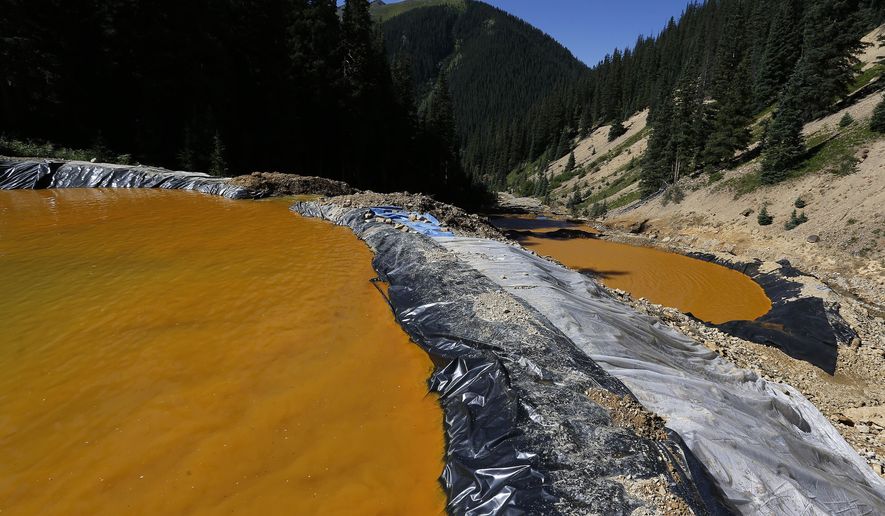DENVER — The Environmental Protection Agency botched the clean-up effort at the Gold King Mine by rushing to complete the job instead of taking precautions that would have prevented the disastrous toxic spill into the Animas River.
A 132-page report released Thursday by the Interior Department and Bureau of Reclamation found that the Aug. 5 accident was not “inevitable,” as the EPA’s own internal review had concluded, but could have been avoided if the agency had followed engineering practices used at other inactive mines.
Rep. Scott Tipton, the Colorado Republican who represents the area, called the investigation’s finding “outrageous.”
“It’s outrageous that the EPA was doing this work without having an understanding of the conditions in the mine or the potential environmental impacts downstream should a spill occur,” Mr. Tipton said in a statement. “The EPA is responsible for this disaster and will be held accountable.”
According to the report, the agency committed a pivotal error by failing to gauge the level of wastewater behind the collapsed rock and soil at the mine, which could have been done by using a drill rig to “bore into the mine from above and directly determine the level of the mine pool prior to excavating backfill at the portal.”
Such a procedure was used successfully in a 2011 reclamation project at the nearby Red and Bonita Mine.
SEE ALSO: EPA comes under fire following another Colorado mine spill
“Although this was apparently considered at Gold King, it was not done,” said the report. “Had it been done, the plan to open the mine would have been revised, and the blowout would not have occurred.”
The report, which was peer-reviewed by the U.S. Geological Survey and the Army Corps of Engineers, was significantly tougher on the EPA than the agency’s own internal review team, which found that the blowout “was likely inevitable” and praised the agency’s quick action afterward in avoiding fatalities.
The EPA review also defended the decision not to use a drill rig to determine the water level behind the debris, saying it “would have been quite costly and require much more planning and multiple field seasons to accomplish.”
“Although difficult and therefore expensive and technically challenging, this procedure may have been able to discover the pressurized conditions that turned out to cause the blowout,” said the EPA report.
That review, released Aug. 24, came three weeks after an EPA-led crew accidentally unleashed 3 million gallons of toxic wastewater into the Animas River near Silverton, Colorado, turning the water orange and cutting off water supplies to communities downstream.
The uproar over the spill prompted a visit and an apology from EPA Administrator Gina McCarthy, as well as promises to clean up the damage and reimburse farmers, ranchers and businesses for their losses.
EPA spokeswoman Nancy Grantham noted that the agency itself had requested an Interior investigation into the spill.
“EPA will carefully review the report,” she said in a statement. “This report, in combination with the findings of EPA’s internal review of the incident, will help inform EPA’s ongoing efforts to work safely and effectively at mine sites as we carry out our mission to protect human health and the environment.”
She added that the decision not to bore into the Gold King Mine with a drill rig came after the internal review team “found that site conditions made it difficult to undertake such drilling to determine pressure within the mine.”
The more extensive Interior Department investigation also concluded that EPA officials pay too little attention to the engineering challenges associated with mining reclamation projects in their zeal to address the environmental damage from the hundreds of abandoned mines from the Gold Rush that dot Colorado and the West.
“The current state of practice appears to focus attention on the environmental issues,” said the report. “Abandoned mine guidelines and manuals provide detailed guidance on environmental sampling, waste characterization, and water treatment, with little appreciation for the engineering complexity of some abandoned mine projects that often require, but do not receive, a significant level of expertise.”
Sen. Cory Gardner, Colorado Republican, said he was “deeply troubled” by the report’s conclusion that the spill was preventable.
“I fully expect accountability and transparency from the EPA, and I look forward to a response to my questions surrounding the EPA’s insufficient and untimely recovery efforts and its proactive measures to prevent a disaster of similar magnitude in the future,” Mr. Gardner said.
Mr. Tipton also reiterated his call for so-called Good Samaritan legislation, which would remove regulatory hurdles discouraging conservation groups and others with reclamation expertise from undertaking clean-up efforts.
“There’s a better way to address contamination in abandoned and inactive mines than the EPA’s status quo which lacks the technical expertise to accomplish the goal,” Mr. Tipton said. “By empowering the people on the ground who have the engineering expertise and have been working locally to address the problems in these mines for years, we can truly make strides to clean them up and limit further harm to the environment.”
• Valerie Richardson can be reached at vrichardson@washingtontimes.com.




Please read our comment policy before commenting.